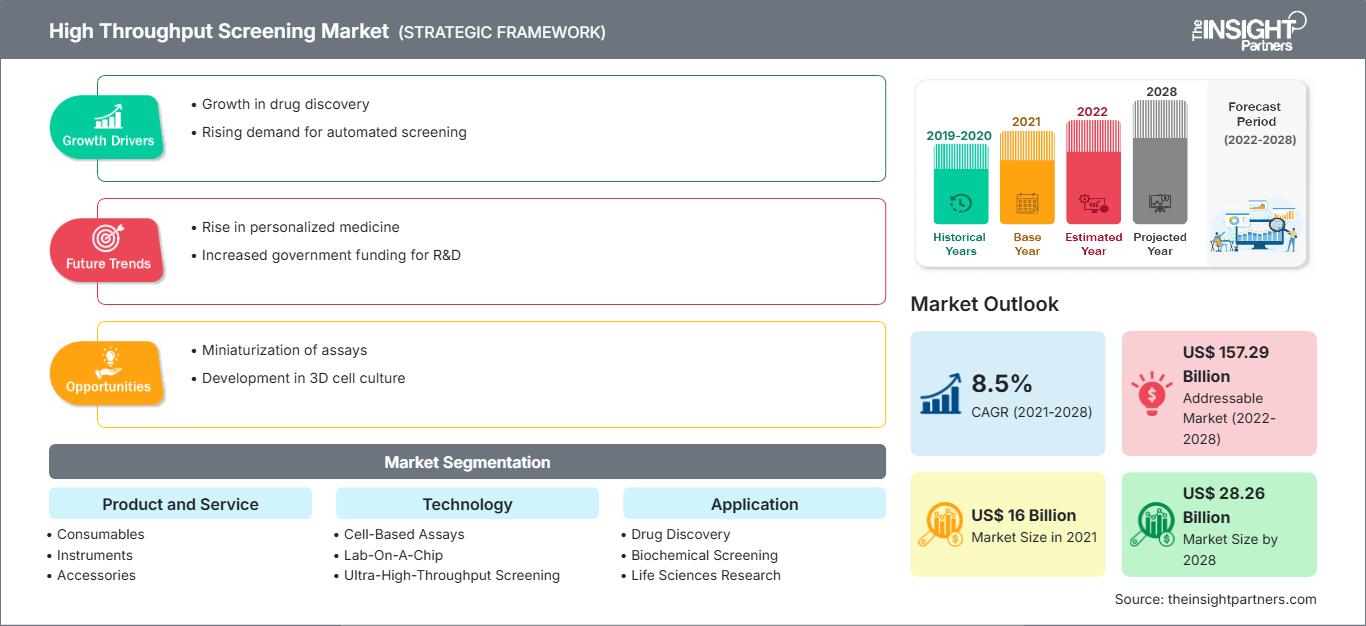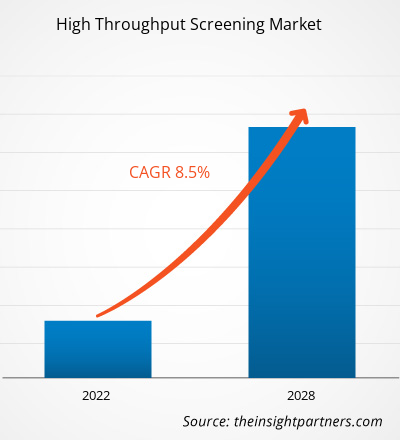Der Markt für Hochdurchsatz-Screening soll von 15.997,47 Millionen US-Dollar im Jahr 2021 auf 28.255,71 Millionen US-Dollar im Jahr 2028 anwachsen. Von 2021 bis 2028 wird ein Marktwachstum von durchschnittlich 8,5 % pro Jahr erwartet.
Hochdurchsatz-Screening (HTS) ist eine Methode zur Arzneimittelforschung, die das automatisierte Testen verschiedener chemischer oder biologischer Verbindungen auf ein bestimmtes biologisches Ziel ermöglicht. Hochdurchsatz-Screening-Methoden sind in der Pharmaindustrie weit verbreitet und nutzen Robotik und Automatisierung, um die biologische oder biochemische Aktivität einer signifikanten Anzahl von Molekülen, in der Regel Arzneimittel, schnell zu testen. Sie beschleunigen die Zielanalyse, da große Verbindungsbibliotheken bald kostengünstig gescreent werden können. HTS ist ein wertvolles Instrument zur Bewertung pharmakologischer Ziele sowie zur pharmakologischen Profilierung von Agonisten und Antagonisten für Rezeptoren (wie GPCRs) und Enzyme. Faktoren wie steigende Investitionen in Forschung und Entwicklung Die Entwicklungen der Pharma- und Biotechnologiebranche und die Einführung technologisch fortschrittlicher Produkte auf dem Markt für Hochdurchsatz-Screening dürften das Marktwachstum in den kommenden Jahren ankurbeln. Die hohen Kosten des Hochdurchsatz-Screenings, der Mangel an ausgebildeten Fachkräften und die Komplexität der Testentwicklung werden das Marktwachstum in den kommenden Jahren jedoch voraussichtlich hemmen.
Markteinblicke
Steigende Investitionen der Pharma- und Biotechnologiebranche in Forschung und Entwicklung
Steigende Ausgaben der Pharma- und Biotechnologieunternehmen für Forschung und Entwicklung sowie bedeutende Medikamentenpipelines zur Behandlung verschiedener chronischer Krankheiten wie Herz-Kreislauf-Erkrankungen, Krebs, Immunstörungen, Stoffwechselstörungen und neurologischen Störungen sind wichtige Treiber für den Markt für Hochdurchsatz-Screening. Mehrere große und kleine Pharmaunternehmen sind an der Entwicklung und Herstellung neuer Moleküle für lebensbedrohliche Krankheiten beteiligt. Dies hat zur Wahl automatisierter Hochdurchsatz-Screening-Methoden (HTS) geführt, um riesige chemische Bibliotheken zu screenen und so den Bedarf an immer mehr Zielmolekülen für Medikamente zu decken. Ein automatisiertes Hochdurchsatz-Screeningsystem kann beispielsweise an einem einzigen Tag rund 10.000 bis 100.000 Zielverbindungen screenen. Pharma- und Biotech-Unternehmen haben in den letzten zehn Jahren erheblich in Hochdurchsatz-Screening-Techniken investiert. Die berühmte Allianz aus Millennium Pharmaceuticals, Inc. und Bayer AG hat beispielsweise in weniger als acht Monaten 18 neue Wirkstofftargets entdeckt und vier davon ins Hochdurchsatz-Screening gebracht. Die Allianz wendet einen neuen Produktionsansatz auf Grundlage der Genomforschung an, um Moleküle möglichst schnell in klinische Studien zu bringen. Hochdurchsatz-Screening gilt als entscheidende Technologie im Arzneimittelentdeckungsprozess. So sind über 60 % der vollständig entwickelten Leitstrukturoptimierungsprogramme von Boehringer Ingelheim auf die erfolgreiche Implementierung von HTS zurückzuführen. Allein in den USA werden jährlich über 2,5 Milliarden US-Dollar für HTS-Produkte und -Dienstleistungen ausgegeben. Große Pharmaunternehmen investieren jährlich bis zu 35 Millionen US-Dollar in Screening-Technologien. Ein erheblicher Teil dieser Investitionen fließt in die Entwicklung neuer Tests.
Passen Sie diesen Bericht Ihren Anforderungen an
Sie erhalten kostenlos Anpassungen an jedem Bericht, einschließlich Teilen dieses Berichts oder einer Analyse auf Länderebene, eines Excel-Datenpakets sowie tolle Angebote und Rabatte für Start-ups und Universitäten.
Markt für Hochdurchsatz-Screening: Strategische Einblicke

-
Holen Sie sich die wichtigsten Markttrends aus diesem Bericht.Dieses KOSTENLOSE Beispiel umfasst Datenanalysen, die von Markttrends bis hin zu Schätzungen und Prognosen reichen.
Eine steigende Zahl von Wirkstofftargets für das Screening, das für die Arzneimittelforschung und -entwicklung verwendet wird, und wachsende Investitionen von Regierungen und Forschungsinstituten werden die Einführung von HTS-Techniken weiter vorantreiben. So hat beispielsweise Sygnature Discovery, ein unabhängiges, integriertes Auftragsforschungsinstitut für Arzneimittelforschung und präklinische Forschung mit Sitz in Großbritannien, im Dezember 2020 rund 4,12 Millionen US-Dollar in die Stärkung seines Hochdurchsatz-Screenings (HTS) und seines translationalen Onkologie-Service investiert. Darüber hinaus nutzen Programme wie „Toxicology in the 21st Century“ – ein Joint Venture der US-amerikanischen FDA, der Umweltschutzbehörde und des US-amerikanischen National Institute of Health – automatisiertes HTS zum Testen von Chemikalien, Formulierungen und Umweltmedikamenten, für eine umfassende toxikologische Untersuchung und zur Entwicklung spezifischer, mit der Krankheit verbundener Pfade zur Vorhersage der toxikologischen Werte. Solche Unternehmungen werden die Verbreitung des Hochdurchsatz-Screening-Marktes unterstützen.
Produkt- und servicebasierte Einblicke
Basierend auf Produkt und Service wird der Markt für Hochdurchsatz-Screening in Verbrauchsmaterialien, Instrumente, Zubehör, Software und Dienstleistungen unterteilt. Im Jahr 2021 hatte das Segment Verbrauchsmaterialien den größten Marktanteil und wird im Prognosezeitraum voraussichtlich die schnellste CAGR verzeichnen.
Technologiebasierte Einblicke in die Berichtsabdeckung
Basierend auf der Technologie wird der Markt für Hochdurchsatz-Screening in zellbasierte Assays, Lab-on-a-Chip, Ultrahochdurchsatz-Screening, Bioinformatik und markierungsfreie Technologie segmentiert. Im Jahr 2021 hatte das Segment der zellbasierten Assays den größten Marktanteil, während für das Segment Lab-on-a-Chip im Prognosezeitraum die höchste CAGR-Zahl erwartet wird.
Anwendungsbasierte Erkenntnisse
Basierend auf der Anwendung ist der Markt für Hochdurchsatz-Screening in Arzneimittelforschung, biochemisches Screening, biowissenschaftliche Forschung und andere Anwendungen unterteilt. Im Jahr 2021 hatte das Segment der Arzneimittelforschung den größten Marktanteil und wird im Prognosezeitraum voraussichtlich die höchste CAGR-Zahl erwarten.
Endnutzerbasierte Erkenntnisse
Basierend auf dem Endnutzer ist der Markt für Hochdurchsatz-Screening in Pharma- und Biotechnologieunternehmen, akademische und staatliche Institute, Auftragsforschungsinstitute (CRO) und andere unterteilt. Im Jahr 2021 hatte das Segment der Pharma- und Biotechnologieunternehmen den größten Marktanteil, während das Segment der Auftragsforschungsinstitute (CROs) im Prognosezeitraum voraussichtlich die höchste durchschnittliche jährliche Wachstumsrate (CAGR) aufweisen wird.
Verschiedene Unternehmen, die auf dem Markt für Hochdurchsatz-Screening tätig sind, verfolgen Strategien wie Produkteinführungen, Fusionen und Übernahmen, Kooperationen, Produktinnovationen und die Erweiterung ihres Produktportfolios, um ihre Präsenz weltweit auszubauen, ihren Markennamen zu wahren und die wachsende Nachfrage der Endverbraucher zu befriedigen.
Hochdurchsatz-Screening
Regionale Einblicke in den Markt für Hochdurchsatz-ScreeningDie Analysten von The Insight Partners haben die regionalen Trends und Faktoren, die den Markt für Hochdurchsatz-Screening im Prognosezeitraum beeinflussen, ausführlich erläutert. In diesem Abschnitt werden auch die Marktsegmente und die geografische Lage des Hochdurchsatz-Screenings in Nordamerika, Europa, dem asiatisch-pazifischen Raum, dem Nahen Osten und Afrika sowie Süd- und Mittelamerika erörtert.
Umfang des Marktberichts zum Hochdurchsatz-Screening
| Berichtsattribut | Einzelheiten |
|---|---|
| Marktgröße in 2021 | US$ 16 Billion |
| Marktgröße nach 2028 | US$ 28.26 Billion |
| Globale CAGR (2021 - 2028) | 8.5% |
| Historische Daten | 2019-2020 |
| Prognosezeitraum | 2022-2028 |
| Abgedeckte Segmente |
By Produkt und Service
|
| Abgedeckte Regionen und Länder |
Nordamerika
|
| Marktführer und wichtige Unternehmensprofile |
|
Dichte der Marktteilnehmer im Bereich Hochdurchsatz-Screening: Verständnis ihrer Auswirkungen auf die Geschäftsdynamik
Der Markt für Hochdurchsatz-Screening wächst rasant. Dies wird durch die steigende Endverbrauchernachfrage aufgrund veränderter Verbraucherpräferenzen, technologischer Fortschritte und eines stärkeren Bewusstseins für die Produktvorteile vorangetrieben. Mit der steigenden Nachfrage erweitern Unternehmen ihr Angebot, entwickeln Innovationen, um den Verbraucherbedürfnissen gerecht zu werden, und nutzen neue Trends, was das Marktwachstum weiter ankurbelt.

- Holen Sie sich die Markt für Hochdurchsatz-Screening Übersicht der wichtigsten Akteure
Markt für Hochdurchsatz-Screening – nach Produkt und Dienstleistung
- Verbrauchsmaterialien
- Reagenzien und Testkits
- Laborgeräte
- Instrumente
- Liquid-Handling-Systeme
- Detektionssysteme
- Zubehör
- Software
- Dienstleistungen
Markt für Hochdurchsatz-Screening – nach Technologie
- Zellbasierte Assays
- Lab-On-A-Chip
- Ultra-Hochdurchsatz-Screening
- Bioinformatik
- Markierungsfreie Technologie
- Oberflächenplasmonenresonanz
- Reflektive Interferometrie
- Isotherme Titrationskalorimetrie
- Differential Scanning Kalorimetrie
- Mikrocantilever
- Kohlenstoffnanoröhren
- Photonische Kristalle
- Sonstige
Markt für Hochdurchsatz-Screening – nach Anwendung
- Wirkstoffforschung
- Biochemisches Screening
- Biowissenschaften
- Sonstige Anwendungen
Markt für Hochdurchsatz-Screening – nach Endbenutzer
- Pharma- und Biotechnologieunternehmen
- Akademische und staatliche Institute
- Auftragsforschungsinstitute (CRO)
- Sonstige
Markt für Hochdurchsatz-Screening – nach Geografie
-
Nordamerika
- USA
- Kanada
- Mexiko
-
Europa
- Frankreich(APAC)
- China
- Indien
- Südkorea
- Japan
- Australien
- Übriger Asien-Pazifik-Raum
-
Naher Osten und Asien Afrika (MEA)
- Südafrika
- Saudi-Arabien
- VAE
- Übriger Naher Osten und andere Länder. Afrika
-
Südamerika (SAM)
- Brasilien
- Argentinien
- Restliches Süd- und Mittelamerika
Firmenprofile
- Agilent Technologies, Inc.
- Axxam SPA
- Eurofins Scientific
- Corning Incorporated
- Molecular Devices, LLC.
- Hamilton Company
- Merck Group
- Perkinelmer, Inc.
- Tecan Group
- Thermo Fisher Scientific Inc.
- Frankreich(APAC)
- Historische Analyse (2 Jahre), Basisjahr, Prognose (7 Jahre) mit CAGR
- PEST- und SWOT-Analyse
- Marktgröße Wert/Volumen – Global, Regional, Land
- Branchen- und Wettbewerbslandschaft
- Excel-Datensatz
Aktuelle Berichte
Erfahrungsberichte
Grund zum Kauf
- Fundierte Entscheidungsfindung
- Marktdynamik verstehen
- Wettbewerbsanalyse
- Kundeneinblicke
- Marktprognosen
- Risikominimierung
- Strategische Planung
- Investitionsbegründung
- Identifizierung neuer Märkte
- Verbesserung von Marketingstrategien
- Steigerung der Betriebseffizienz
- Anpassung an regulatorische Trends






















 Kostenlose Probe anfordern für - Markt für Hochdurchsatz-Screening
Kostenlose Probe anfordern für - Markt für Hochdurchsatz-Screening